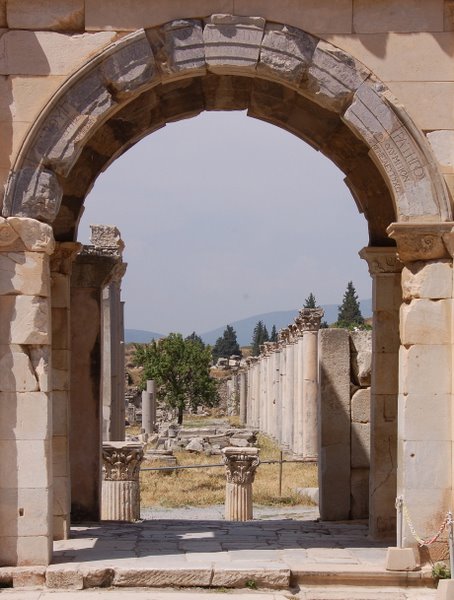 Located in modern Turkey, ancient Ephesus was the capital of the Roman province of Asia. It stood at the end of one of the greatest trade routes through Asia, ending at the Cayster River. Its temple to Diana (Artemis) was one of the seven great wonders of the ancient world – four times larger than the Parthenon in Athens. The city thrived on worship of Diana, and flourished in the sale of silver statues and other goodies used in the worship of Diana.
Located in modern Turkey, ancient Ephesus was the capital of the Roman province of Asia. It stood at the end of one of the greatest trade routes through Asia, ending at the Cayster River. Its temple to Diana (Artemis) was one of the seven great wonders of the ancient world – four times larger than the Parthenon in Athens. The city thrived on worship of Diana, and flourished in the sale of silver statues and other goodies used in the worship of Diana.
As a major city in Rome’s time, Paul interacted quite a bit with this town. It was here that Paul left Priscilla and Aquila for a time. It was also here in Ephesus that Apollo, the traveling preacher, came and started preaching boldly about the baptism of John the Baptist. When Priscilla and Aquila heard him, they invited him home to dinner and filled in the gaps on his theology. Once they set his record straight, he became a mighty man in God’s Kingdom. (Acts 18:24-28) And John the Apostle spent quite a bit of time here. Tradition holds that he moved here with Mary, Jesus’ mother, and tended to the church here.
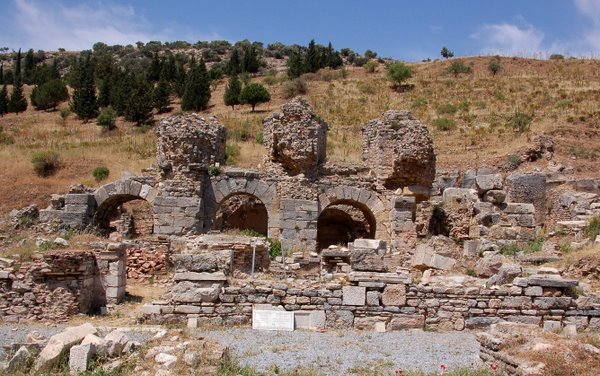 |
When the seven sons of Sceva (a Jewish chief priest) tried to imitate Paul by casting out demons in Paul’s name, they got the tar beat out of them, running out of the house naked and bleeding. This sent the fear of God through the people and many Jews and Greeks decided they needed to convert to Christ. (Acts 19:13-18). As people flocked to Christianity, they abandoned their pagan ways – they didn’t just abandon them, they burned them. When they calculated the value of their sorcery and scrolls, the value was 50,000 drachmas. (This is the Bath of Varius. It was built of cut marble and had 3 sections: frigidarium, tepidarium and caldarium (cold, warm and hot water). |
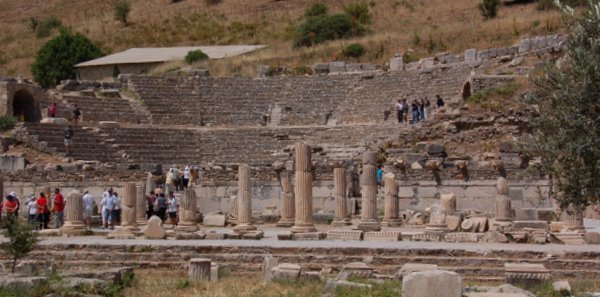 |
One drachma is about a day’s wage. If that’s $100 in today’s money, we’re looking at $5,000,000! When you’re burning that kind of money, someone’s bound to get ticked off.
Here’s the Odeon amphitheater. It was constructed in the 2nd century AD and could seat 1500 people. |
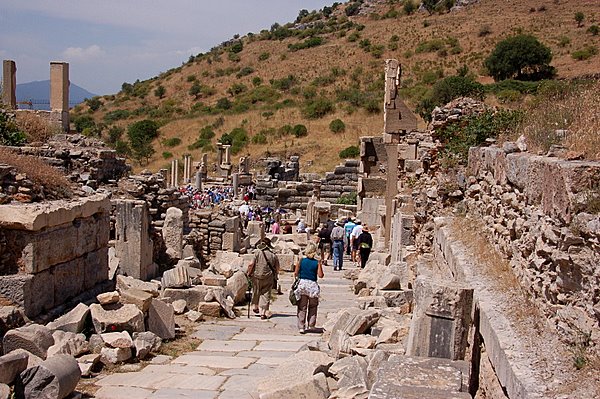 |
|
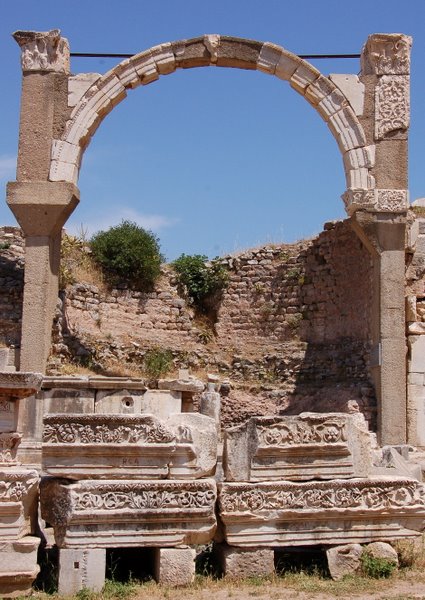 |
Here’s the Fountain of Pollio. Constructed by the Temple of Domitian in dedication to C. Sextillius. It used to e covered with marble slabs and decorated with statues in front. One of the statues from this fountain is currently on display in the Museum of Ephesus. The fountain was built in 97AD – after Paul had left. |
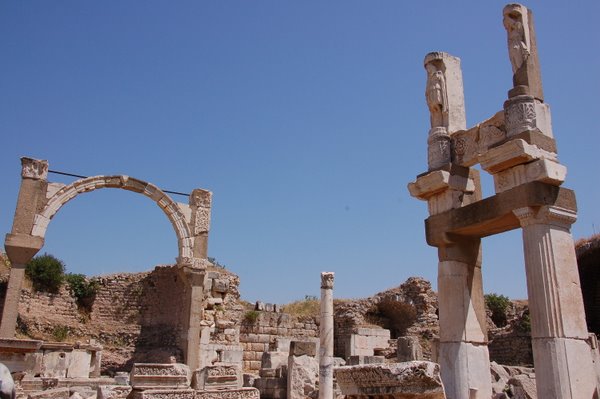 |
The Temple of Domitian is on the right. It had a shops on the first floor and the temple on the second floor. It was built in honor of Domitian. |
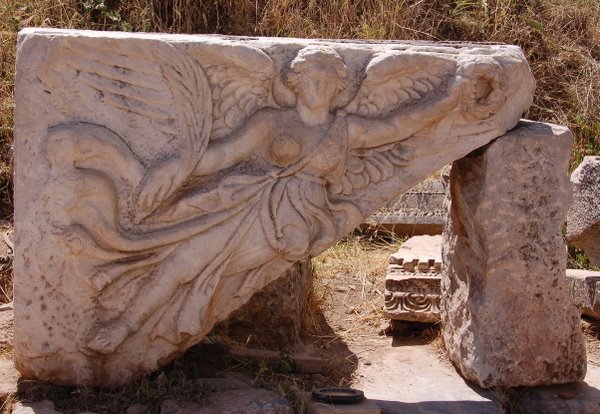 |
Nike, the goddess of victory. She’s holding a wreath of laurel leaves in her left hand and a stalk of wheat in her right. |
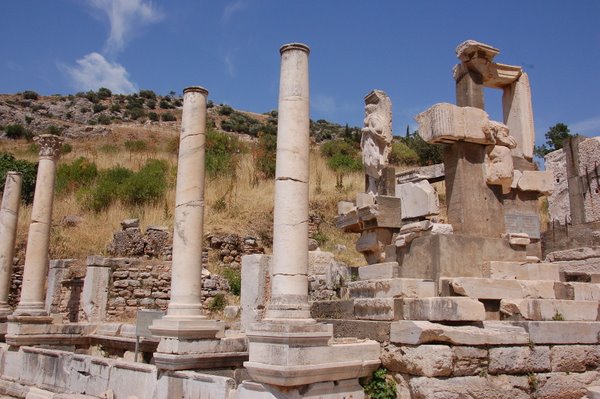 |
Memorial to Memmius. Located on the north side of the Domitian Square, the memorial was built to commemorate Memmius’ grandfather, Sulla.
When taxes were exorbitantly high, Sulla led a revolt against the Romans and killed 80,000 Romans. |
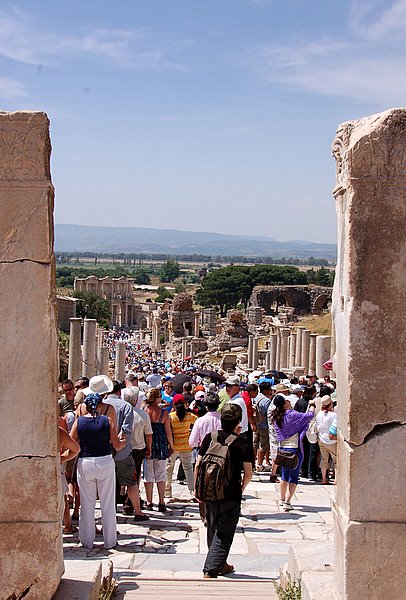 |
Lots of people! I was surprised to see that it was a more crowded than any of the other places we went, including the Acropolis in Athens. This is looking through the Heracles Gate (pillars on the left and right), down Curetes Street to the Celcus Library. |
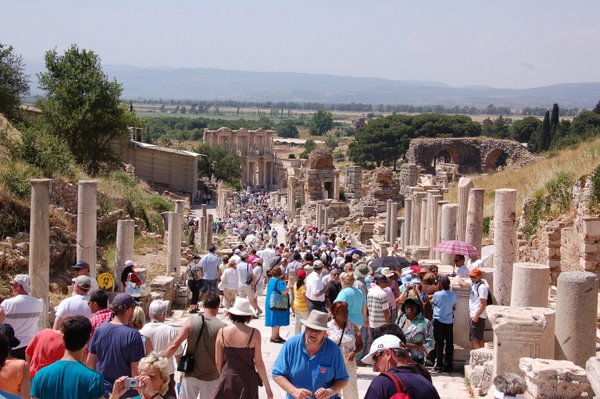 |
You can see the Celsus Library of Ephesus in the distance. It was built in the 2nd century AD. |
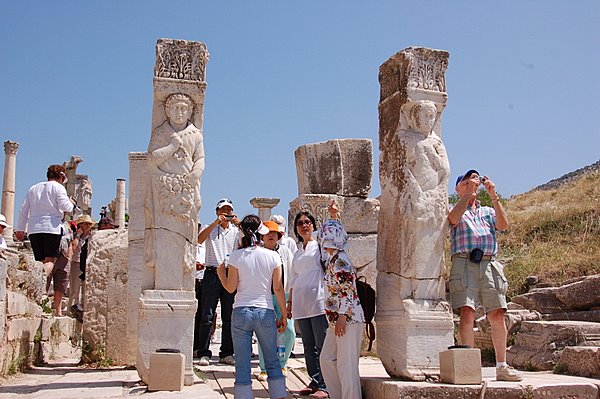 |
Other side of the Heracles Gate. |
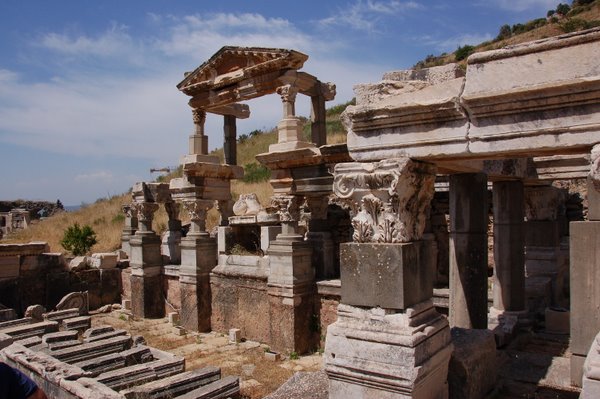 |
The Fountain of Trajan with the Panayir mountain in the background. This was a two-story fountain, with the first story 21 feet high and the 2nd 15 feet high. The pool in the fountain was 60′ x 30′. Twelve statues of Venus, Saturn, Dionysos and the successors of the Imperial Family were discovered here.
The fountain was built sometime during the fist century AD, so Paul may have seen it too. It’s one of the finest buildings in Ephesus. |
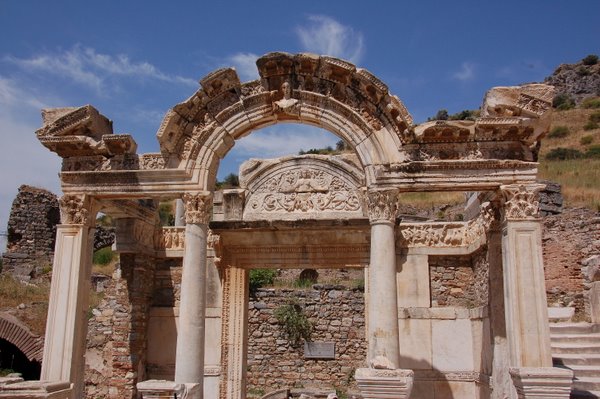 |
Right after the Fountain of Trajan is the Temple of Hadrian. It was built by Theodosius in 391AD in honor of his father, a general who was hanged innocently. On the opposite side of the street facing the temple was a group of houses for the rich. |
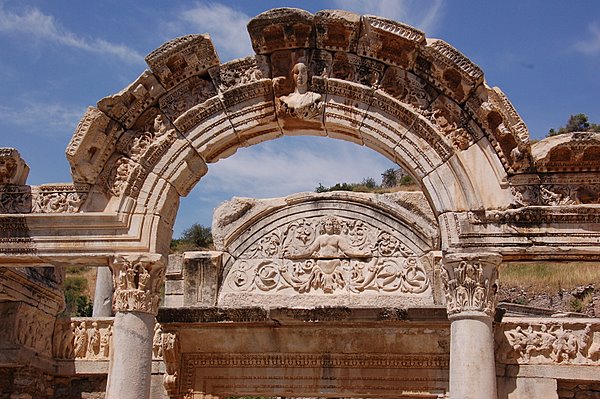 |
Closeup of the detail in the temple arch. Somebody spent a lot of time, effort and energy to carve all that detail. |
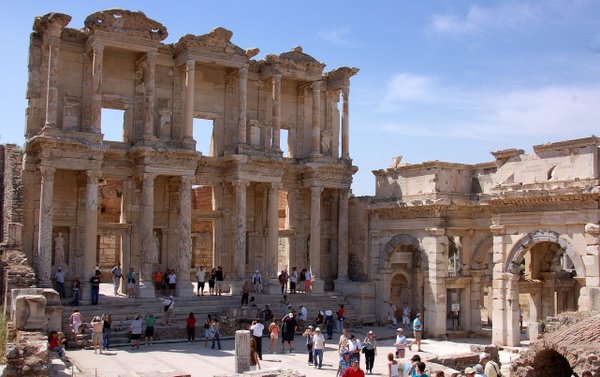 |
The Celsus Library of Ephesus (on the left). It was built in 117 A. D. It was a monumental tomb for Gaius Julius Celsus Polemaeanus, the governor of the province of Asia; from his son Galius Julius Aquila. The grave of Celsus was beneath the ground floor, across the entrance and there was a statue of Athena over it.
A lot of times when I see stone pillars, I wonder how strong Samson must have been to pull down that temple and kill all those Philistines. And when I see rickety, reconstructed stone pillars, I think “I bet I could push those pillars down”. I’ve never tried it tho. |
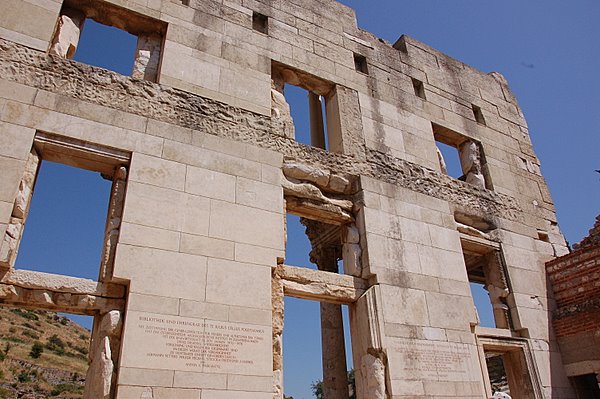 |
The scrolls of the manuscripts were kept in cupboards in niches on the walls. There were double walls behind the bookcases to prevent the them from the extremes of temperature and humidity. The capacity of the library was more than 12,000 scrolls. It was the third richest library in ancient times after the Alexandra and Pergamum.
The backside of the front wall of the Library of Ephesus (bet you don’t see that everyday, eh?) |
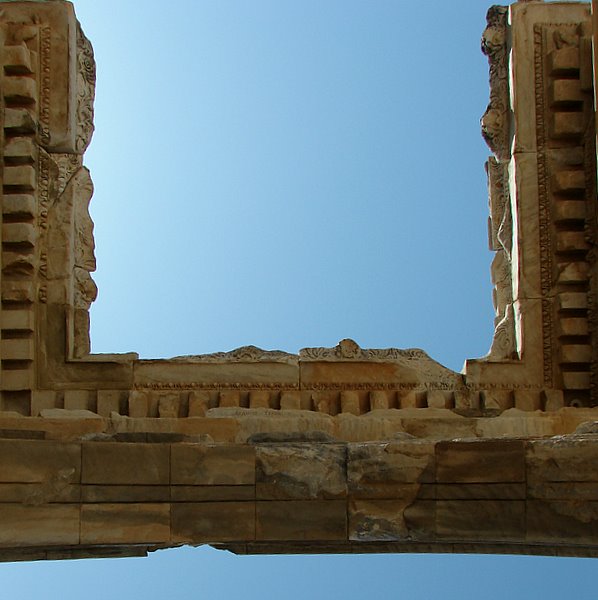 |
Detail of the stonework on the underside of the right-most arch of the photo two photos above. It’s the Gate of Mazeus. It was built in 43AD, so Paul would have seen it during his stay in Ephesus. |
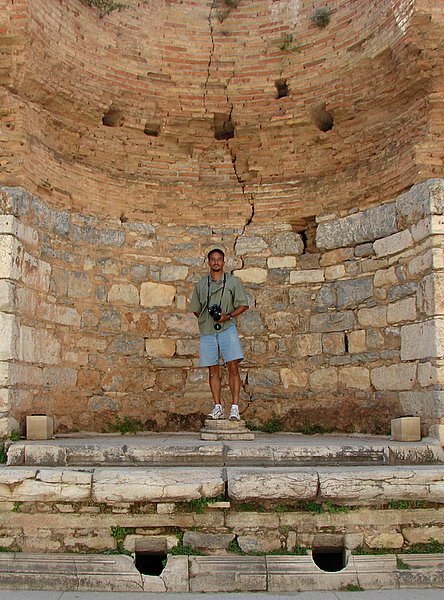 |
If you look straight ahead when you enter the Library of Ephesus, you’ll see this pretty cool altar thing. It’s pretty impressive. But if you hand your camera to a tourist that doesn’t understand scale or know how to frame a photo (or doesn’t understand “here. . hold this camera right here and don’t zoom in – just press this button when I say ‘go’), you get this photo. Oh, well. At least he didn’t run off with my camera. |
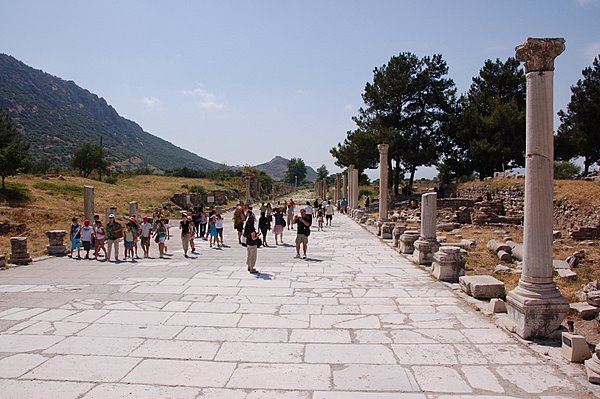 |
Here’s a view down Marble Street. |
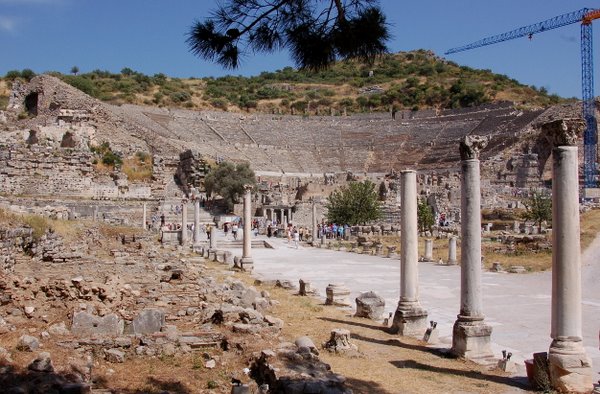 |
When Paul started attracting many converts, the silversmiths saw their sales being impacted. Led by Demetrius, they rustled up a good-sized mob and dragged Paul to the great theater shouting “Great is Artemis of Ephesus”. In the legal proceedings that ensued, Paul was compelled to leave the city. This is the amphitheater that Paul was dragged to when he kicked up a ruckus with the silversmiths in Ephesus. They didn’t appreciate his converts not buying their statues of Diana. Put a crimp in their business. |
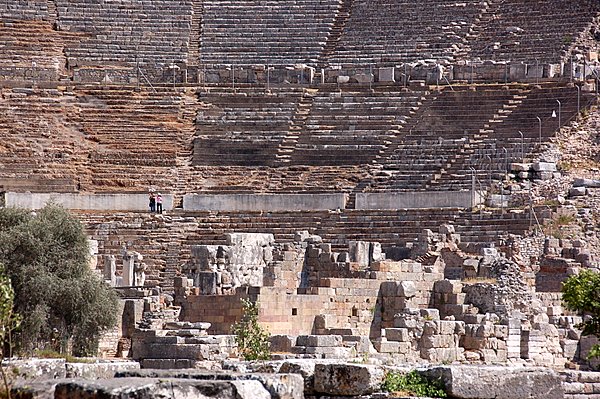 |
Close-up of the amphitheater. The place is huge! You can see two people standing at the left to give you a sense of scale. |
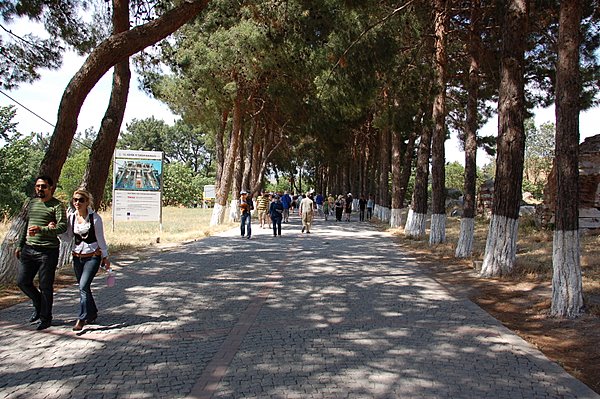 |
Thankfully this area was very breezy. |
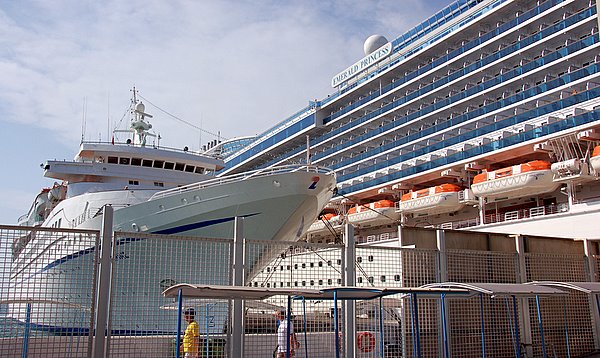 |
Meanwhile, back at the ship – If anyone thought our 600-ft ship was huge, this Emerald Princess ship removed all doubt. It was at least 200-ft longer and probably 100-ft taller. Made our ship look like a rowboat! Unfortunately, there was no place to get a good angle to show the difference in sizes. |
Here’s a map of ancient Ephesus, from http://www.turizm.net/cities/ephesus/excavations. html
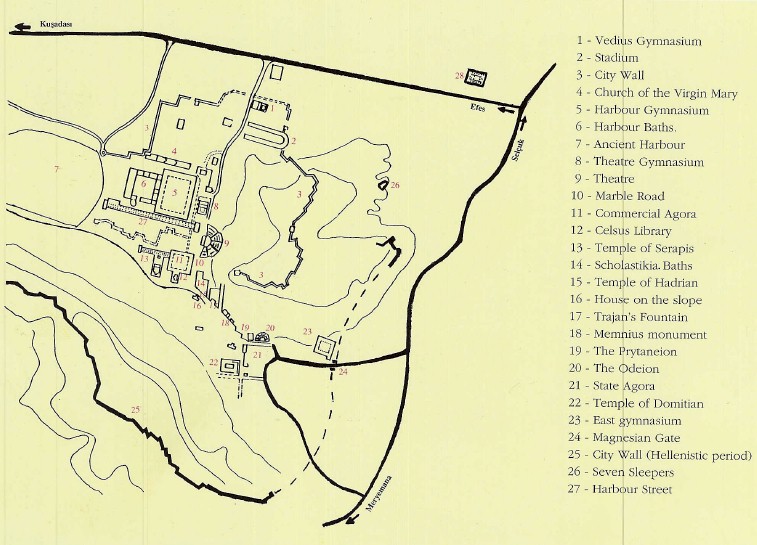
Entrance at Ephesus (Southeast portion of map, near Magnesian Gate)
Ephesus
Curetes Street
Fountain of Trajan
Temple of Hadrian
Library of Celsus
Amphitheater
